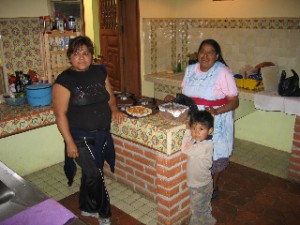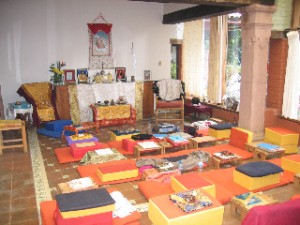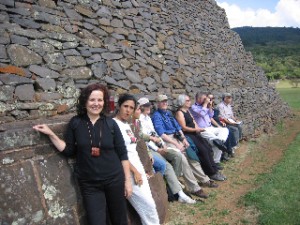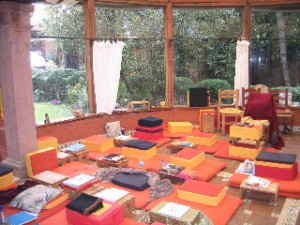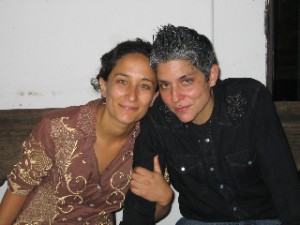Saturday
Mandala Projects, World, otherInspiring Retreat at Casa Werma
My wife, Jean, and I drove in to Patzcuaro at sunset on September 30th, 2008. We’d made previous arrangements with Acharya Allyn Lyon and Eve Halpern to staff the upcoming Werma Retreat at Casa Werma from October 3-10, on our way back from Boulder, Colorado, to our Mexico home of Bucerias on the west coast, just above Puerto Vallarta. Of course, we wandered through the streets of town for half an hour, arguing over directions, before we pulled up to the large entry door of Casa Werma.
Eve and her partner, Cristina Sandoval, were happy to see us and, as we are old friends of Eve’s family, we had a lot to talk about. This was to be the first large retreat of any kind at Casa Werma. Since arriving several months before, Eve and Cristina—along with local workers, Jorge, Angie and Alvaro—had been working 10 hours a day to prepare for this, clearing the land of years of debris, renovating the buildings, adding rooms and planting new gardens. Cristina’s experience as a building contractor was invaluable in this massive undertaking.
Inside “el bosque”
Casa Werma, well-known for the site where Chogyam Trungpa Rinpoche revealed the Werma Sadhana in 1980, is located near the center of Patzcuaro, and encompasses five acres of wooded land behind high adobe walls. (We discovered that some locals who have never been inside those walls refer to Casa Werma as “el bosque”—the forest.) There are several buildings on the land: a main house with a glassed-in shrine room, three bedrooms and a large patio, a “casita” for dormitory housing, and the “gate house” used as Eve and Cristina ’s residence, office and guest room. A storage building with a newly built shower and bathroom sits nearby. Toward the back of the property a “troje”—a traditional Purepecha Indian pine house—has been restored. The property itself is beautiful, with pine, juniper, avocado, orange and macadamia trees throughout. Abundant beds of roses, daylilies and agapanthias are planted concentrically around a grassy area and a central Jacaranda tree.
A big project still left two days before the retreat was repainting and preparing the shrine room, which we completed just hours before the first participants arrived. Angela Pressberger, who lives in Patzcuaro, joined us and helped to create a beautiful Shambhala shrine.
Acharya Lyon and the participants arrived on October 2 and settled in to rooms and dorms. Seventeen participants in all, we came from Tepotzlan, Cuernavaca, San Miguel de Allende, Mexico City, Canada and the U.S.
We began our seven-day Werma retreat with a large lhasang on the patio of the main building, the very patio where Trungpa Rinpoche had received the Werma Sadhana 28 years to the month before! During the lhasang and throughout the week, we all experienced the powerful drala energy of Casa Werma.
We soon settled into our retreat routine: wake-up at 6:30 to coffee and tea, optional exercises and drill practice until breakfast at 8:30 (Acharya Lyon joined us as Corporal Halpern led us through drill); morning sadhana practice from 9:30-12:30; lunch; afternoon sadhana practice and a talk by Acharya Lyon from 3:00-6:00; dinner; and evening practice, talk or discussion from 8:00-10:00. It was difficult at first to practice for so many hours at a time, but it was amazing how quickly we accustomed ourselves to this routine. Acharya Lyon’s talks on various aspects of the sadhana and our Shambalian society were always delightful, filled with humor and insight. Gary Hubiak had also brought audiotapes of talks by Acharya John Rockwell, which were inspiring.
Good to the last bite
Breakfasts and lunches were prepared by a local cook, Angelina and her family, who made most of the meals on an open fire. It became a daily lunch ritual for the various dishes of enchiladas, burritos, tamales, beans, vegetables and fruit to be laid out on the large dining room table. Then Eve described the local name and ingredients for each dish before we lined up to fill our plates and eat every last bite. At the end of each meal, many of us would personally thank a beaming Angelina and her family for the unique and delicious food. For dinner we were on our own, which gave us an opportunity to explore Patzcuaro.
A large mountain pueblo near the city of Morelia in central Mexico, Patzcuaro was inhabited by the Purepecha/Tarascan Indians before the coming of the conquistadors. Just down the street from Casa Werma is a huge outdoor market with hundreds of booths selling everything from food to clothing to DVDs. In the center of town are the Plaza Grande and Plaza Chica, around which are many houses, shops and restaurants. On a hill overlooking the town is the great basilica, first commissioned to be built in the early 16th century, finally completed in the 17th, destroyed by fire in the 18th and rebuilt in the 19th. This is the seat of one of the Archbishops of Mexico, and is a major pilgrimage site, particularly during “Semana Santa,” or Holy Week. Patzcuaro is perhaps best known through magazines and videos for its ritual during “Dia de Los Muertos” (Day of the Dead) when families of the deceased boat by candlelight to a central cemetery on Janitzio Island in Lake Patzcuaro, to hold vigil through the night, sharing food and relating stories of past relatives. Indeed, the local skeletal “Katrina” dolls have become popular throughout Mexico and the world.
One afternoon we all took a break from our practice routine to visit Tzintzuntzan, about 15 miles outside of Patzcuaro and overlooking Lake Patzcuaro. Tzintzuntzan means “Place of the Hummingbirds,” and served as the seat of the great Purepecha Empire before the coming of the Spaniards. The site is renowned for its five massive “yacatas,” or pyramids, that are conjectured to have supported five great temples.
Practicing so intensely together over the week brought our small group very close socially and emotionally. On the final day we celebrated a Werma feast with a final talk by Acharya Lyon. Eve and Cristina joined us for the feast and to accept our heartfelt thanks for their great effort, kindness and generosity. We all parted company for our respective homes the next day so inspired to have practiced the Werma Sadhana in Casa Werma!
Casa Werma regularly hosts practice programs and is also a bed and breakfast inn. For further information, visit www.casawerma.shambhala.org or contact Eve Halpern at [email protected].

